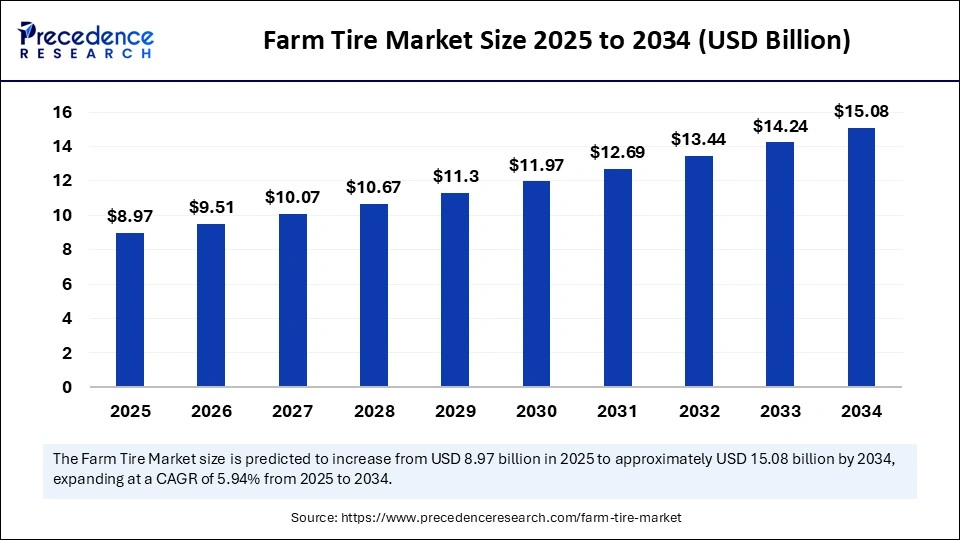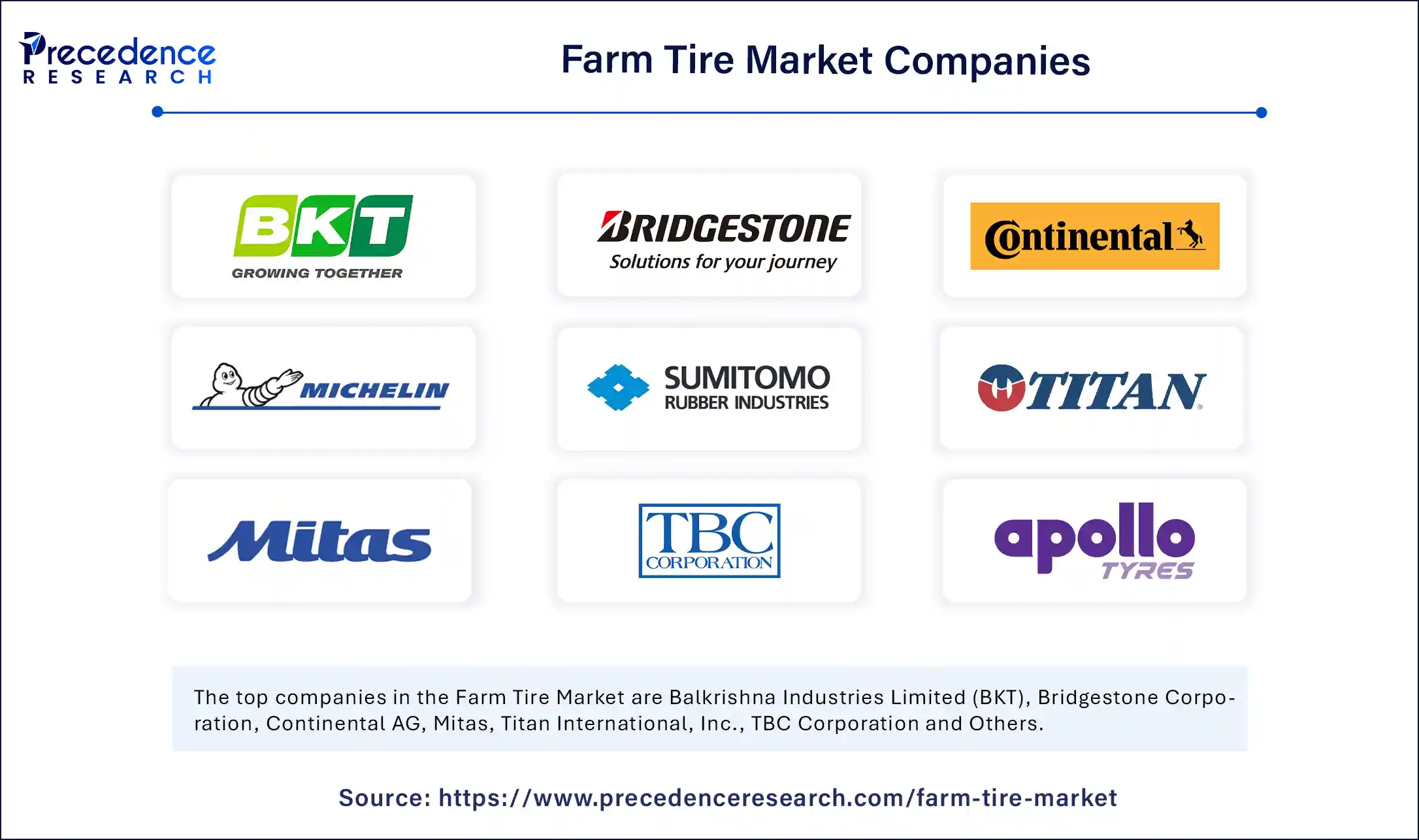Farm Tire Market Size to Surpass to USD 15.08 Billion by 2034

Farm Tire MarketKey Takeaways
- In terms of revenue, the farm tire market is valued at $8.97 billion in 2025.
- It is projected to reach $15.08 billion by 2034.
- The market is expected to grow at a CAGR of 5.94% from 2025 to 2034.
- Asia Pacific dominated the global market with the largest market share of 44% in 2024.
- Europe is expected to witness the fastest CAGR of 5.2% during the forecast period.
- By product, the bias tires segment held the largest revenue share of 58% in 2024.
- By product, the radial tires segment is expected to grow at a significant CAGR of 5.6% during the forecast period.
- By distribution channel, the aftermarket segment captured the biggest market share of 62% in 2024.
- By distribution channel, the OEM segment is anticipated to grow at a rapid pace over the forecast period.
- By application, the tractors segment held the largest revenue share of 45% in 2024.
- By application, the harvesters segment is expected to expand at a significant CAGR in the upcoming period.
How is Artificial Intelligence Revolutionizing the Farm Tire Market?
The farm tire market is undergoing revolution, improving performance, efficiency, and precision. This is achieved through the integration of AI technology, which uses sensors embedded in tires to continuously monitor pressure, temperature, and wear. Farmers receive notifications about equipment failures and recommendations to optimize field performance. This data enables predictive maintenance and reduces downtime.
Market Overview
The Farm Tire Market plays an integral role in the global agricultural machinery industry, supporting the operational efficiency and mobility of equipment such as tractors, harvesters, balers, and sprayers. As agriculture becomes more capital-intensive and technology-driven, the role of specialized tires has grown significantly. Farm tires must perform in diverse environments, including muddy fields, uneven terrain, and paved rural roads, making quality and design critical for performance. The market is broadly segmented into original equipment manufacturers (OEMs) and aftermarket channels, both of which are witnessing significant activity due to increasing mechanization, seasonal replacement demand, and evolving consumer preferences. The demand for high-durability tires that offer better traction, reduced slippage, and soil preservation is accelerating the Farm Tire Market’s global growth.
Drivers
Several key factors are fueling the growth of the Farm Tire Market. The increasing adoption of advanced tractors and combines in agriculture is one of the strongest drivers. Farmers are investing in high-performance machinery to improve yield and reduce dependence on manual labor. These vehicles require robust tires capable of supporting heavy loads while delivering efficiency in field conditions. The rise in smart farming practices, which involve GPS-enabled machinery and precision planting, also requires compatible tires designed to minimize ground impact. Moreover, the aftermarket segment is growing rapidly as farmers replace worn-out tires seasonally or in response to weather conditions. Increasing awareness about the benefits of radial tires, including better fuel efficiency and longer life span, is shifting customer preference away from conventional bias tires in many regions.
Opportunities
The Farm Tire Market offers vast growth potential in value-added services such as on-site tire repair, mobile fitting units, and subscription-based tire replacement plans. Companies that offer bundled services with tires and after-sales support are gaining a competitive advantage, especially in remote farming areas. There’s also an increasing opportunity in digital tire management systems that allow farmers to monitor usage, schedule replacements, and reduce downtime. Another major growth area lies in developing countries with large agricultural populations but low levels of mechanization. Vendors who can offer affordable yet durable tire options stand to benefit in these markets. Additionally, there is growing scope in designing tires specifically for emerging electric tractors and hybrid farm vehicles as the industry moves toward sustainability.
Challenges
The Farm Tire Market faces various challenges, including inflationary pressures on raw material costs such as rubber, carbon black, and synthetic compounds. These fluctuations affect pricing strategies for both OEMs and aftermarket players. In rural markets, lack of awareness and access to modern tire maintenance practices leads to uneven wear and reduces overall product lifespan, impacting brand reputation and demand. Logistics and inventory management remain a concern in developing regions, where tire availability and timely delivery are inconsistent. Additionally, the transition from bias to radial tires is hampered by infrastructure limitations in certain areas where road conditions and farm layouts are not suitable for modern tire technologies.
Regional Insights
Regionally, Asia Pacific holds the dominant share in the Farm Tire Market, thanks to vast agricultural land, large rural populations, and government-led farm mechanization initiatives. India and China, in particular, are driving demand for affordable tractor tires and expanding OEM markets. Europe is seeing steady growth in advanced tire types, driven by eco-conscious farming and soil health regulations. North America continues to lead in premium tire adoption, supported by high-end agricultural technology and large-scale commercial farms. The Latin American market is growing as countries invest in agriculture to boost exports. In Africa and the Middle East, foreign investments and climate-resilient farming practices are contributing to gradual market development.
Recent Developments
In recent years, the Farm Tire Market has witnessed a wave of innovation, including the use of recycled and bio-based materials in tire production. Manufacturers are also investing in AI-powered systems for predictive maintenance and performance analytics. OEM collaborations with precision agriculture companies have led to the development of tires that can adapt to field conditions in real-time. Mobile apps for farmers to track tire pressure, wear, and alignment are becoming popular among tech-savvy users. Expansion into Tier 2 and Tier 3 cities through digital sales channels and dealer networks is also helping global brands capture replacement market share. Environmental compliance and carbon footprint reduction strategies are influencing R&D pipelines, with a focus on lightweight and recyclable tire models.
Farm Tire Market Companies

- Balkrishna Industries Limited (BKT)
- Bridgestone Corporation
- Continental AG
- Compagnie Générale des Établissements Michelin (CGEM)
- Sumitomo Rubber Industries, Ltd.
- Titan International, Inc.
- Mitas
- TBC Corporation
- Apollo Tyres Ltd.
- Hankook Tire
- MRF Limited
- JK Tyre & Industries Ltd.
- CEAT
- The Carlstar Group, LLC
- Specialty Tires of America, Inc.
- Alliance Tire Group (ATG)
- Trelleborg AB
Segments Covered in the Report
By Product
- Bias
- Radial
By Application
- Tractors
- Harvesters
- Forestry
- Irrigation
- Implements
- Sprayers
By Distribution Channel
- OEM
- Aftermarket
By Region
- North America
- Asia Pacific
- Europe
- Latin America
- Middle East & Africa
Get Sample@ https://www.precedenceresearch.com/sample/6219
